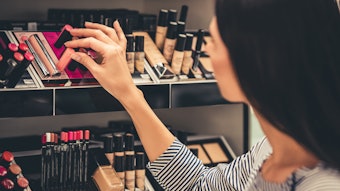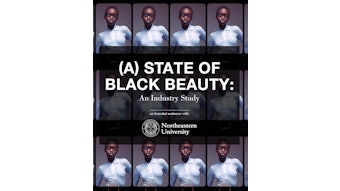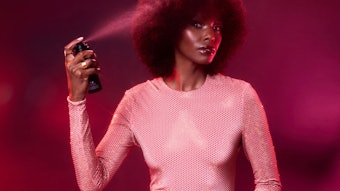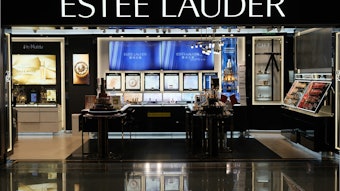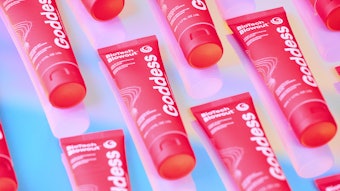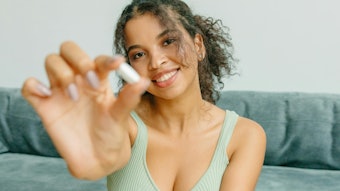“Hair color evolves like art and fashion,” said Brad Johns, global color director, Clairol. From New York to Milan, fashion has a huge influence on hair trends. Therefore, marketers and suppliers carefully monitor those trends and incorporate them into product development.
According to Johns, three color trends are emerging for fall 2006: a warm, solid color; a warm base with tiny highlights all through, so it’s multi-tonal but not drastic; and a warm base with highlighted pieces around front. Celebrities also are bringing back darker shades, providing richness, sex appeal and sophistication for brunettes. For a more drastic look, Sue Pemberton, artistic director, Vero, translated today’s cultural duality and fall fashion trends into hair by placing contrasting hues diagonally, horizontally and vertically to simulate the graduations in texture and color of traditional Scottish Highland tartans and tweeds.
In response to these trends, consumers are looking for bold highlights, multihued layers and rich hues in all-over color. This has led to the introduction of deep tones of eggplant, burgundy and mahogany. Also, strategically placed highlights, lowlights or panels that accentuate the texture in hairstyles are on the rise this season.
Trends, however, extend beyond color. Educated consumers demand a lot from their hair products. “While a large percentage is looking to distinguish themselves or make statements with their hair color, many also desire results with as little damage to the hair as possible,” said Mabel Covey, vice president of science and technology, Hair Systems Inc.
This need to minimize damage due to chemical processes and environmental elements has led to the introduction and promotion of “demi” and nonammonia hair colors over the past several years. “We are also seeing a strong desire on the trendsetting consumers’ part to have shiny hair and longer-lasting color,” she added.
About two-thirds of women, for whatever reason, color their hair. But the growing social acceptability of coloring one’s hair for purely fashion purposes, rather than to conceal gray, says something about how women perceive hair color as part of their personality. At the same time, consumers are looking to enhance those aspects of their hair that they find desirable while also taming the undesirable ones. These consumer needs represent product opportunities that deserve consideration by marketers and ingredient suppliers alike.
To accommodate the trend for multidimensional hair color, Revlon Custom Effects Highlighting and Lowlighting Kits, launched in January, provide subtle or dramatic highs and lows that give hair color depth and movement. In this two-step process, either highlighting cream or lowlighting hair color is applied using a comb applicator. Then the patented shampoo-in Smart Toner, formulated with a low level of oxidative hair dye, cleanses the hair and deposits brightening color to the highlighted/lowlighted strands. The oxidative dye in the Smart Toner reacts with the residual peroxide left in the highlighted or lowlighted strand after rinsing.
The key to great highlighting is proper placement of the highlights following the removal of melanin—the hair’s natural color. Innovations in how the highlighting products are applied make it easier for consumers to use them at home. Herbal Essences Highlights from Clairol offers a unique color-indicating formula so consumers can see where they are placing the highlights. In this case, the success of the product also goes beyond the formulation. Since June, three Herbal Essences Highlighting kits also include a newly designed two-in-one comb, giving consumers the option for either fine or bold highlights. The comb has two chambers on one end and a single chamber on the other end, further enabling users to vary highlights.
“Today’s beauty consumer is much more savvy and experimental than in the past—even eager to try different products to create a variety of looks and styles,” said Mercedes Orpin, product development manager, Bumble and bumble . Bumble and bumble Hair Powder products, launched in March, provide temporary color that’s applied directly onto the roots and hair, and then can be brushed through the hair. The powders feature a unique blend of iron oxides for color and aluminum starch, magnesium carbonate and silica for oil absorbency, volume and texture. “The powders provide a subtle hint of color while providing a dry texture so styles stay put,” said Orpin. Bumble and bumble’s interest in powder stemmed from session stylist Laurent Phillippon’s frustration that only white versions, which were noticeable on all but blonde hair, were available.
Three technical considerations in product development were significant. The first was finding the appropriate tone for each shade. Submissions were tested on a variety of hair colors to see if they blended, enhanced or shifted the color. Second was striking the balance of powder base to propellant. “We needed the right amount of powder for the product to perform properly, but we had to take into consideration spray pattern, amount of powder dispensed, force of propellant and overall drying time,” said Orpin. The third consideration was packaging components—specifically finding the best combination of valve and gasket options for optimal product application.
Herbal Essences Colorflirt Mousse, launched by Clairol in March, also allows consumers to experiment with new colors. “The semi-permanent colorant product uses a very different technology from permanent colorants,” explained Frauke Neuser, PhD, senior scientist, Clairol. It does not contain any ammonia or peroxide and the dye molecules, known as direct dyes, are pre-formed so there is no product mixing. “The color molecules don’t penetrate the hair; they get ‘stuck’ in the cuticle layers and wash out,” Neuser explained. Consumers also have control over the intensity of the color—the longer they leave it on, the more color they get.
On the ingredient side, suppliers have accommodated fashion trends characterized by vibrant colors, highlights and unique effects by providing formulators with chormophores of high brilliancy and tinctorial strength. Ciba Specialty Chemicals’s Vibracolor hair dye is one such example. “It combines the most brilliant shades with excellent stability and fastness properties,” said Michael Schork, marketing manager, colorants and stabilizers, Ciba.
Lasting Impressions
Glazing and post-color treatment products that promote longer-lasting color represent a potential area of growth in the hair color segment, especially considering the vibrancy of today’s colors. In fact, the most recent product launches from Clairol have been based on the realization that consumers’ desire to maintain the look and feel of just-colored hair longer. “We have found that there is a roller coaster of emotions for consumers,” explained Clairol’s Neuser. Following an initial exuberance, they tend to feel a decline in satisfaction. This has led to the development of products that maintain or boost color appearance and hair quality between colorings. Nice ’n Easy Color Boosting Glaze is just one salon-inspired product that delivers a boost of color and shine in five minutes.
Ingredient innovation plays a substantial role in longer-lasting color. Croda’s most recent ingredient innovation is the Keratint EZ hair tint emulsifying system, available since April. “Keratint EZ helps increase the dye penetration, thus longer-lasting color,” explained Charles Moses, research manager, ethnic products and hair color, Croda. Designed to simplify hair color formulations, the pastille is a one-step conditioning and emulsifying package for creating stable, cost-effective emulsions. Keratint consists of a balanced ratio of Crodafos CES, a phosphate ester that provides better hair dye penetration for truer, longer-lasting color; Incroquat Behenyl TMS, a quaternary conditioning agent that contributes to detangling; and Procetyl AWS, a pH-stable ether that contributes to moisturization.
Crodafos HCE, from Croda’s line of phosphate esters, works by aiding in the delivery of dye actives to promote a faster coloring rate inside the hair cortex. This allows hair color formulators to create hair dyes with more color uptake, greater color intensity and better color wash-fastness, as shown by studies using a Hunter LabScan Spectrocolorimeter.
Looking Natural
Despite the vibrant colors available, consumers have become selective in choosing natural-looking colors in the right tone. A study by Redken showed that 85% of those looking to change their hair color are looking for a subtle to moderate color change, rather than a dramatic or unusual change. In response, Redken offered its first ammonia-free, one-level lift permanent color cream to salons in June. Shimmer One is a permanent color that uses a chemical process to permanently alter the state of hair, replacing melanin with a dye. Yet, it also has several characteristics of a demi-permanent color, depositing color only on the surface of the hair. Shimmer One lifts the hair from its natural color up one level in the 10-level scale of tonality of natural color. This provides consumers with more natural-looking, longer-lasting color but a less drastic commitment and less visible re-growth. The formulation features Tri-Light Technology, an active complex of luminizing dye molecules for long-lasting color, mango butter to smooth and moisturize, and rice protein to strengthen the hair. “This branded technology is being marketed in all of Redken’s future products to communicate the importance of key active ingredients that help differentiate our products among other brands,” explained Kirsten Marsh, senior director, hair color and texture, U.S. marketing, Redken.
Similarly, L’Oréal Paris introduced its one-level lift Natural Match in the spring. L’Oréal’s Color-Calibrated Technology creates a spectrum of 24 refined ammonia-free, permanent shades that could not be delivered using traditional, nonpermanent technology. In addition, the unique package features a “before” swatch on the front and a convenient mirror on the box to guide consumers in their color selection.
Sensory Benefits
Consumers are looking for more than longer-lasting color and easier-to-use products. “They also desire secondary benefits like improved sensory properties,” said Steve Carbone, marketing manager, polymer systems, Ciba.
Coloring pre-treatments, for example, prepare the hair to optimize color deposition along the hair fiber and at the root area while providing even color coverage from root to tip. “Hair tips usually are porous (caused by environmental damage and excessive styling), and can grab color like a sponge, which leads to uneven color results,” said Clairol’s Neuser. Hydrience Crème Moisturizing System is a three-step system that provides hair with moisturizing protection before, during and after the coloring process to provide even, rich color. “Positively charged conditioning ingredients deposit onto the hair’s surface and help neutralize the negative charge of stressed hair to protect it and keep it moisturized,” explained Neuser. Clairol also has the ColorSeal Gloss Conditioner, featured in its Nice ’n Easy products, to lock in color and impart lasting conditioning properties.
Innovative ingredients and concepts play a significant role in bringing enhanced quality of products to consumers. “The sole purpose of a hair color used to be to deliver the expected color and, as a side benefit, the hair had body and fullness after the process,” explained Hair Systems’ Covey. “Now—in an effort to minimize damage and to help maintain healthy hair—functional proteins, moisturizers, silicones, cationic conditioners and UV protectors are all included in hair color formulations, none of which would be possible without new technology and R&D.”
Burgeoning Markets
The hair coloring market has struggled due to a combination of product over-saturation and stiff competition among a few manufacturers. The previously dynamic sector has lost ground in the U.S., France and Spain, yet sales in Italy improved slightly last year, driven largely by the performance of conditioners and hair color—of which L’Oréal is the indisputable leader, according to Mintel International Group Ltd.
Innovation and catering to burgeoning consumer groups interested in coloring can breathe new life into the market. “Driven by the empowerment of women and the antiaging trend, men recognize the need to compete to look better,” said Redken’s Marsh. Of the three top major manufacturers, Combe, Inc. has seen the most positive gains, indicating the potential power of the men’s market. Combe’s Just For Men, which recently introduced three new colors, is the world leader in men’s hair color. The brand has a no-mess, five-minute maxim, and its new True Color formula targets only the gray hair for a natural look. “Men want to look younger longer, but they want it quick and simple—and they don’t want anyone to notice,” said Marsh.
Redken, which introduced its men’s line two years ago, is just one company that has made a commitment to steady long-term growth in this market. “It’s about changing the entire mentality and lifestyle of the population and redefining masculinity. That’s not going to happen overnight,” Marsh added.
The growing tendency for teens to experiment with appearance also has potential to increase sales in the market. This is especially true in the U.K., where the hair color market is being driven by trends—multitonal, highlighted and temporary effects—that have burgeoned from the youth market. In addition, the emerging and extremely experimental youth market in Japan is influencing Europe, which in turn influences the U. S. “We are seeing more young girls, even boys, experimenting with hair color,” added Marsh. “It is a form of self-expression for teenagers to define who they are.”
Salon Service
In order to ensure growth for the future, the hair color market will need to reconcile the tension between the options of home color and the salon services. The salon hair care segment continues to be plagued by product diversion—the selling of salon products through retail channels—which has increased over the past five years. In addition, salon products are facing increased competition from “masstige” brands. “(A trip to the salon) used to be about quality, but now salon-inspired retail products can give consumers the same quality at home,” said Clairol’s Johns. Yet, while manufacturers have developed at-home beauty alternatives, the indulgent nature of salon treatments is still a powerful draw. According to a study by Redken, the percentage of women coloring only in salons at the end of last year already was up 40% from 2002.
It comes down to customization and the salon experience. “Stylists really listen to clients and prescribe, in partnership with the clients, what they need to meet their desires,” said Redken’s Marsh. Redken is utilizing a new Web site and aggressive consumer advertising in fashion magazines, in addition to special events, to de-mystify hair color for consumers.
Global Growth
As the market grows, manufacturers continue to be inspired by new ingredient innovations, resulting in enhanced products for the consumer. “Better dyes, better delivery systems, and better color production and maintenance additives are critical to the evolution of hair color,” said Ciba’s Carbone. “Future products must be multifunctional—meaning offering color, conditioning and protection all in one product.” Manufacturers also must consider ingredient safety, intensity of color, ease of use and impact on sensory properties of hair.
Manufacturers must continue to focus on formulating globally acceptable products, meaning they must keep up with constantly changing regulations in international markets. “Many hair dyes have been de-listed in some countries, and the fate of some dyes is yet to be determined,” said Hair Systems’ Covey. Although many of the dyes for vibrant tones have been de-listed for safety and regulatory reasons, the consumers’ demand for rich tones has not changed. As new products are introduced, developers will have to ensure that formulations are globally acceptable before incorporating them into products destined for a global market.


